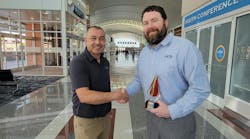It's in the Bank
Attracting air service through financial commitment of the business community
By Jodi Prill, Associate Editor
August 2002
The challenge of air service development is continually being addressed by airports and the communities they serve. Mike Boggs, former airport manager, offers one potential solution involving the business community, Travel Banks™, which promotes air service as well as economic development.
"The
idea [of a travel bank] was the result of a lot of meetings with airlines
and a lot of frustration between myself and the local business community
in Eugene (OR), and not being able to figure out a way to influence airline
decisions in favor of the community," explains Boggs, manager of
airport business services for Mead & Hunt, a consulting firm based
in Madison, WI. "We were looking for a way to increase the Eugene
community's negotiating power with airlines for air service."
And that negotiating power is the travel
bank. According to Boggs, a travel bank is formed when a community organization
- generally comprised of the airport, chamber of commerce, and businesses
- and an airline reach a contractual agreement stating that if the airline
provides air service to a market, those businesses will use the service.
Businesses are "locked-in" with the financial commitment by
money deposited in the travel bank that can only be used toward purchases
with a special credit card through the specified airline.
A travel bank is effective because "it
locks in the commitment of the business community," Boggs says. So
when the airline begins providing service, the businesses use the service.
Banking in Pensacola
Pensacola
(FL) Regional Airport has had a travel bank with AirTran Airlines
since November 2001. According to Frank Miller, airport director,
the venture has been a success.
"People
are using it (travel bank), it's doing exactly what we said it would
do and it's really convenient for them."
Pensacola is a small hub airport,
with last year's enplanements totaling 540,000. Miller explains
that the local chamber of commerce and the City of Pensacola had
identified air service as a priority, "so we were working to
bring in a low fare carrier. Hearing about the travel bank at a
meeting Mike (Boggs) attended, I came away thinking that may be
a way to attract a low fare carrier into Pensacola."
Miller spent three long weeks making
presentations to local businesses and was able to attract 327 businesses
and individuals to pledge $2.7 million to the travel bank. He says
the community was ready for something like this, so it was fairly
easy to procure the commitment.
"The air service has resulted
in increased enplanements," Miller says. "Our traffic
for the month of May was up 26 percent over May of last year. It
has also resulted in the airport being able to weather the aftermath
of September 11th. We were tracking like all other airports in September
and October of last year, with a 20 percent-plus decrease in traffic.
In November, when AirTran started service, our traffic was up 5
percent and since then it's been a double digit increase each month."
AirTran offers travelers flights
from Pensacola to AirTran's hub in Atlanta, and then onto 32 other
destinations. Miller explains this is the reason they chose to bring
in AirTran, which "provides service to the majority of our
top destinations for our business travelers."
THE CHALLENGE
Boggs explains there are very few incentives
to offer airlines for providing air service in a new market; but none
appear to be as mutually beneficial as a travel bank.
Incentives such as revenue guarantees,
marketing dollars, and airport landing fee reductions can all be used
alone or in conjunction with each other, but they do not provide the guarantee
that businesses will use the air service like a travel bank does.
THE PROCESS
Boggs has led the way in implementing five
successful travel banks. Two are operating at Eugene Airport, one at Stockton
(CA) Metropolitan Airport, one at Pensacola (FL) Region-al Airport, and
the newest and largest at Wichita (KS) Mid-Continent Airport.
"Wichita is an amazing story,"
Boggs says. "I think it's the largest community driven air service
initiative, at least in the last decade, in the U.S."
Wichita or-ganized a campaign, in the business
community, aimed at securing air service with a low fare carrier to multiple
destinations, including Atlanta and Chicago. The community was able to
raise $7.4 million and, according to Boggs, when AirTran began providing
service in May, there were nearly 400 businesses participating in the
program.
"The most important thing about travel
banks is that what makes them work is not the money - the money only locks
people in to the deal." Boggs explains. "What makes them work
is the broad-based community participation, a broad cross section of the
business community. You can put together a travel bank of $10 million,
but if you only have a couple of companies putting up the money, it would
not be successful."
Boggs also explains that before AirTran
came into the Wichita community, the airline wanted "an insurance
policy" that it would be profitable. The City agreed with a revenue
guarantee.
Generally, an airport along with a chamber
of commerce or other economic development group are the ones that form
a community organization within the business community to develop air
service. "We recommend that it be a business to business deal,"
Boggs says. "The government leaders take a back seat and let the
chamber or economic development group take the lead role in the project.
Businesses don't want to be told by government what they need to do to
fix their problems. They'd rather fix them themselves."
When a community organization approaches
Mead & Hunt for assistance in developing its air service, the most
important aspect is the introductory research that is performed. "In
the beginning, there's a lot of conversation about what they've done in
the past to decide where they are in the overall process," Boggs
says. "Number one, have they done their homework? Have they done
the analysis necessary to understand the market needs and what the market
can support? Because no matter what you do, a travel bank, or anything
else, the market has got to stand on its own."
This data is particularly important before
any additional effort is placed forth in the process. "We don't do
any travel banks that we aren't 100 percent convinced are going to be
successful."
Once the probability of success is determined,
Boggs explains that an organizational meeting is held. The business community
is brought together to discuss the intricacies of the travel bank, including
contracts and credit card system. They also take the time to "make
sure everybody understands not just the mechanics, but also, how much
work it is."
Mead & Hunt then works with the community
organization to develop marketing and presentation material in order to
convey the benefits to businesses and secure participation.
At minimum, Boggs says, travel banks take
12 weeks to put together, usually longer.
Each business has a separate contract with
the travel bank (controlled by the community group), which is generally
one year in length. Ideally, after one year, the ultimate goal has been
achieved and the travel bank is no longer necessary. "It's not intended
as a long-term band-aid," Boggs explains. "The purpose of the
travel bank is to get people on the airlines a few times, get them used
to it, and break their travel habits - what the community promises the
airlines is we're going to get them on you a couple of times, after that
it's up to you to keep them as customers."
One question Boggs says always comes up
when talking to people about travel banks, is whether the business community
will receive special travel discounts. "The answer is no. What you're
leveraging your business community for is competitive air service. And
you're going to pay whatever the level of competition dictates. Air service
is not just about cheap air service. When you take a look at what air
service is to a community, we're not talking about how to get the kids
to see Grandma here. We're talking about air service to support the economic
activity in the community. And any time you can add a destination, decrease
the price of a ticket, or decrease the time it takes to get between two
communities, you increase economic activity in that community. So that's
the argument - it's not cheap tickets, it's air service to support business
activity."






